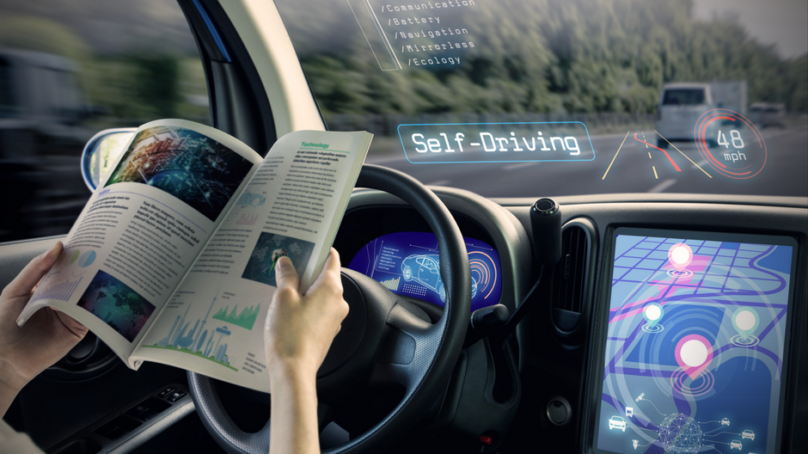
There has been much progress in self-driving technology in recent months, yet these advances may be leading the public to believe that the self-driving revolution is much closer to reality than it actually is.
In fact, Mitch Bainwol, president and CEO of the Alliance of Automobile Manufacturers, recently penned testimony for the Senate Committee on Commerce, Science and Transportation expressing that fully self-driving cars requiring zero human interaction are unlikely to be seen before the year 2025, and large-scale consumer adoption of these vehicles is still decades away.
Given such industry reality checks contrasted by the new innovations making headlines every day, the question becomes: What is hype and what is the reality for today’s auto consumers when it comes to self-driving technology?
Today’s Hype: Fully Autonomous Cars
According to the U.S. Department of Transportation, true autonomy is defined as level 4 or level 5 autonomy; these levels describe the system in the vehicle, not the vehicle itself. At these levels, the system’s performance should be mostly equal to that of a human driver.
To date, one of the biggest hurdles stacked against these level 4 or 5 cars is perfecting LiDAR to work in all weather conditions. LiDAR provides critical knowledge to the cars’ AI or brain and stands for “light detection and ranging.” Dubbed the eyes and ears of the self-driving car, this technology uses near-infrared light to guide the car’s movement, detecting the shape of objects to identify things like driving lanes, traffic signals and even pedestrians along the way. However, the technology is far from able to perform perfectly in various weather.
Additionally, radar is another common technology used in self-driving sensor technology; however, when used alone, radar does a poor job of identifying the objects around it, though it can readily measure distance and speed.
Lastly, a very important component in self-driving cars is the camera, which is unfortunately neither yet a fail-safe technology. Interpreting the information it gathers is essential for a camera to guide a car accurately, and abnormal lighting caused by various, rather common weather conditions—like fog or direct sunlight—can deteriorate cameras’ image quality greatly.
With these very real tech challenges facing them, players in the self-driving car space have many long test miles ahead of them before consumers can get—and snooze—in a wheel-less self-driving car.
The People Problem
Technology aside, at the center of the auto industry’s to-do list is securing positive public sentiment for self-driving cars, as current data shows that today’s consumers aren’t bought into the idea. In fact, 18% of drivers are terrified of self-driving cars, with 25% admitting they wouldn’t even so much as ride in a self-driving car.
However, perhaps it shouldn’t come as a surprise that overall public sentiment is lower than industry leaders have anticipated. Public trust in technology takes considerable time. Take, for example, the introduction of both the airline and automobile industries, where it took many years for the public’s fear to subside before using these modes of transportation became second nature.
Self-driving technology is still years away from gaining the same level of trust that other transportation systems currently enjoy, and in the meantime it will be critical for companies marketing these vehicles to do so in a way that instills confidence in consumers.
Current Reality: Autonomous Features
Though fully self-driving cars might not arrive as soon as the industry is hoping, our current reality of self-driving automobiles is here, and it lies in the autonomous features that are on the market today. These features, or advanced driver-assistance systems, use external and internal cameras, radars, and sensors to detect surroundings and are used for both crash avoidance purposes, as well as driver convenience.
In a vehicle equipped with crash avoidance features, like lane-departure warnings and blind spot detection, many are equipped to actively apply the car’s brakes to prevent a collision with another vehicle. Some systems warn the driver of oncoming dangerous situations in the form of audible, visible and haptic alerts, while many are even programmed to actively guide the vehicle back to safety.
When it comes to convenience, features such as adaptive cruise control and self-park steering take the aggravation out of commuting.
With the rate at which this technology is emerging, combined with the need to achieve customer acceptance, we will see automakers continue to roll out autonomous technology feature by feature, testing the water and gaining trust along the way.
Tomorrow’s Reality
One thing is certain: The automotive landscape is changing, with software likely becoming the forefront of the movement. In fact, technology investor Marc Andreessen of Andreessen Horowitz predicts the future of automotive sales will center around software.
Despite notable setbacks, many automakers claim their fully self-driving cars will hit the roads in the next few years, but those promises will remain to be seen—likely for at least another decade.
About the Author
Founder and CEO of Klashwerks, Russell Ure has a long history guiding the development of leading edge products. Previously, Ure was the CEO of Blacksumac and has held senior product leadership positions at Rove Mobile, Newbridge Networks, Alcatel Networks, TimeStep and Klockwork.



